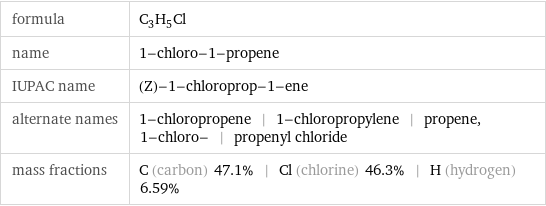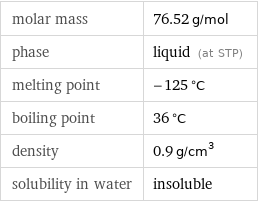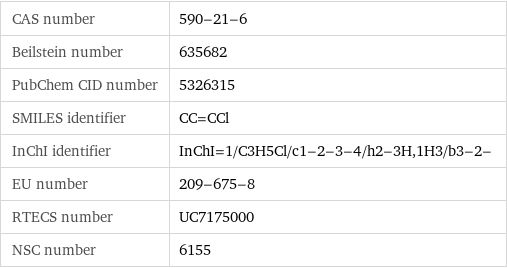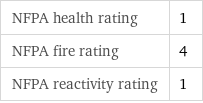Input interpretation

1-chloro-1-propene
Chemical names and formulas

formula | C_3H_5Cl name | 1-chloro-1-propene IUPAC name | (Z)-1-chloroprop-1-ene alternate names | 1-chloropropene | 1-chloropropylene | propene, 1-chloro- | propenyl chloride mass fractions | C (carbon) 47.1% | Cl (chlorine) 46.3% | H (hydrogen) 6.59%
Lewis structure

Draw the Lewis structure of 1-chloro-1-propene. Start by drawing the overall structure of the molecule, ignoring potential double and triple bonds: Count the total valence electrons of the carbon (n_C, val = 4), chlorine (n_Cl, val = 7), and hydrogen (n_H, val = 1) atoms: 3 n_C, val + n_Cl, val + 5 n_H, val = 24 Calculate the number of electrons needed to completely fill the valence shells for carbon (n_C, full = 8), chlorine (n_Cl, full = 8), and hydrogen (n_H, full = 2): 3 n_C, full + n_Cl, full + 5 n_H, full = 42 Subtracting these two numbers shows that 42 - 24 = 18 bonding electrons are needed. Each bond has two electrons, so in addition to the 8 bonds already present in the diagram add 1 bond. To minimize formal charge carbon wants 4 bonds. Identify the atoms that want additional bonds and the number of electrons remaining on each atom: Fill in the 1 bond by pairing electrons between adjacent highlighted atoms: Answer: | |
3D structure

3D structure
Basic properties

molar mass | 76.52 g/mol phase | liquid (at STP) melting point | -125 °C boiling point | 36 °C density | 0.9 g/cm^3 solubility in water | insoluble
Units

Liquid properties (at STP)

density | 0.9 g/cm^3 vapor pressure | 430 mmHg
Units

Thermodynamic properties

critical temperature | 498 K critical pressure | 4.5 MPa (at STP)
Chemical identifiers

CAS number | 590-21-6 Beilstein number | 635682 PubChem CID number | 5326315 SMILES identifier | CC=CCl InChI identifier | InChI=1/C3H5Cl/c1-2-3-4/h2-3H, 1H3/b3-2- EU number | 209-675-8 RTECS number | UC7175000 NSC number | 6155
NFPA label

NFPA label

NFPA health rating | 1 NFPA fire rating | 4 NFPA reactivity rating | 1
Toxicity properties

RTECS classes | tumorigen | mutagen | primary irritant